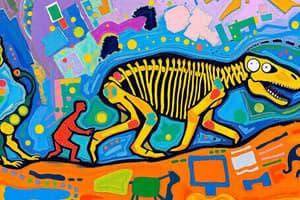Podcast
Questions and Answers
What is the primary function of genes in a living creature?
What is the primary function of genes in a living creature?
- To pass on the DNA to offspring
- To carry life information and determine characteristics and traits (correct)
- To control the mutation of DNA
- To determine the direction of anatomical structures
What is the process called when an individual is subjected to factors such as predators, parasites, and changes in habitat?
What is the process called when an individual is subjected to factors such as predators, parasites, and changes in habitat?
- Mutation
- Recombination
- Hereditary
- Natural Selection (correct)
What is the term for the direction towards the head?
What is the term for the direction towards the head?
- Posterior
- Anterior
- Superior (correct)
- Inferior
What is the result of excess production of offspring?
What is the result of excess production of offspring?
What is the term for the direction towards the midline of the body?
What is the term for the direction towards the midline of the body?
What is the process called when the DNA of two creatures is randomly mixed?
What is the process called when the DNA of two creatures is randomly mixed?
What is the term for the direction towards the surface of the body?
What is the term for the direction towards the surface of the body?
What is the result of a copying error within the DNA?
What is the result of a copying error within the DNA?
What is the term for the direction further to the back?
What is the term for the direction further to the back?
What is the primary function of cells in a living creature?
What is the primary function of cells in a living creature?
Flashcards
Function of genes
Function of genes
Genes carry life information and determine traits.
Natural Selection
Natural Selection
Process where individuals face predators and environmental changes.
Superior direction
Superior direction
Toward the head of a living creature.
Excess offspring production
Excess offspring production
Signup and view all the flashcards
Medial direction
Medial direction
Signup and view all the flashcards
Recombination process
Recombination process
Signup and view all the flashcards
Superficial direction
Superficial direction
Signup and view all the flashcards
DNA mutation
DNA mutation
Signup and view all the flashcards
Posterior direction
Posterior direction
Signup and view all the flashcards
Cell function
Cell function
Signup and view all the flashcards
Study Notes
Evolution
- Develops the diversity of life on earth
- Explains how different species emerged
Species
- A community of animals that can produce offspring with one another
- Members may resemble each other in appearance but have different traits and characteristics
- Each species has unique DNA
Cells and DNA
- Every creature is made up of cells
- Cells have a nucleus containing chromosomes, which hold DNA
- DNA consists of different genes that carry life information
- Genes determine characteristics and traits of a living creature
Creation of DNA
- Excess production of offspring leads to more differences
- Heredity: passing of DNA to offspring
- Recombination: random mixing of DNA from two creatures
- Mutation: random change in DNA, which can be negative (illnesses or cancer) or positive/neutral (e.g., blue eye color)
Keywords
- Random: all evolutionary processes are based on chance
- Selection: each individual undergoes natural selection due to factors like predators, parasites, toxins, habitat changes, and climate
Anatomical Directional Terms
- Used to minimize confusion when discussing body areas
- Anatomical Position: face forward, arms at sides, palms forward, and feet forward
Directional Terms
- Superior: toward the head or upper part of the body
- Inferior: toward the feet or lower part of the body
- Posterior: further back or dorsal
- Anterior: further front or ventral
- Medial: toward the midline of the body
- Lateral: toward the side of the body
- Proximal: closer to the axial body or trunk
- Distal: further from the axial body or trunk
- Superficial: closer to the surface of the body
- Deep: further from the surface of the body
Studying That Suits You
Use AI to generate personalized quizzes and flashcards to suit your learning preferences.




